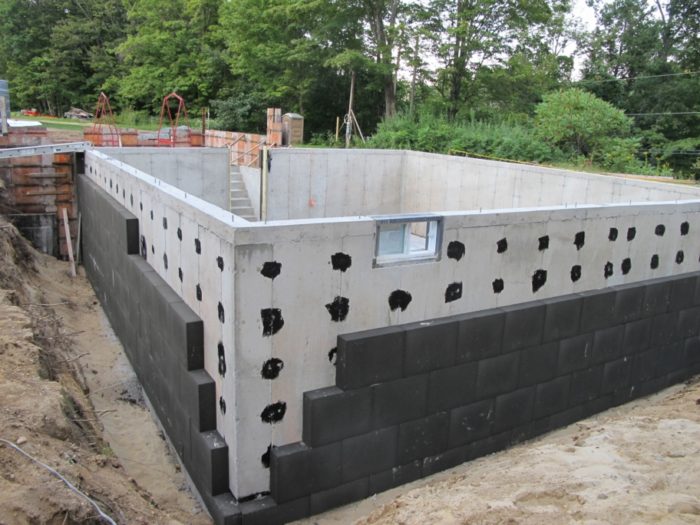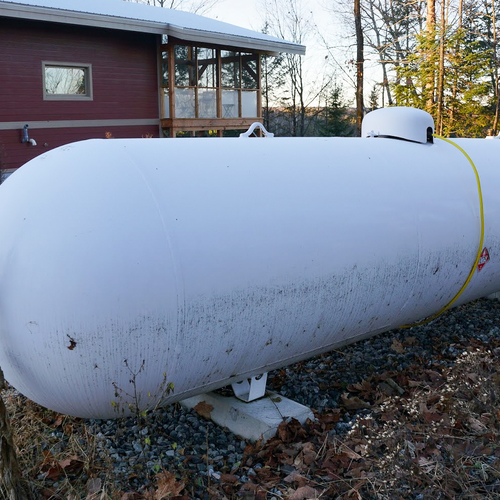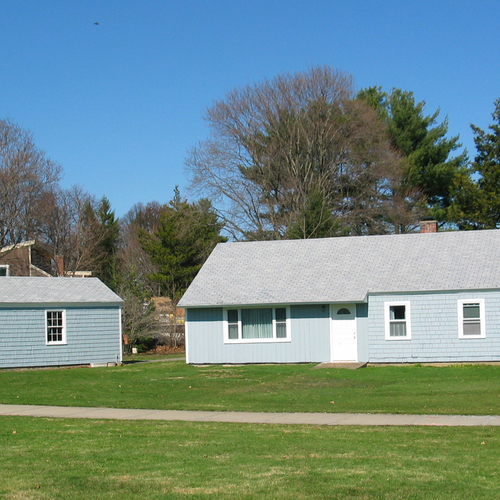Image Credit: Alex Wilson
Image Credit: Alex Wilson Cree's new True White Cree Bulb offers a CRI of over 90, and it's reasonably affordable. But prices still need to drop to capture greater market share.
Image Credit: Cree We need better, less expensive options for creating grid-connected solar-electric systems that can deliver power when the grid is down.
Image Credit: Alex Wilson A plug-in hybrid vehicle charged using a net-metered PV array at the Philadelphia Navy Yard.
Image Credit: Alex Wilson
I spend a lot of time writing about innovations in the building industry — the cool stuff that’s coming out all the time. But I also like to think about what’s needed: stuff that’s not (yet) on the market or performance levels not yet available. This week I’ll describe a few such products, systems, and enhancements.
Rigid insulation with no flame retardants and insignificant global warming potential
Readers of this blog may be aware that I’ve been highly critical of the brominated and chlorinated flame retardant chemicals added to nearly all foam-plastic rigid insulation today as well as the high-global-warming-potential blowing agents used in extruded polystyrene. I would love to see affordable alternatives. They could be new formulations of polystyrene or polyisocyanurate that doesn’t require flame retardants or inorganic materials that are inherently noncombustible. I’m intrigued by advanced ceramics and could imagine a foamed ceramic insulation being developed that meets these criteria.
A really good exterior insulation system for existing houses
We need to dramatically improve the energy performance of existing houses, and one important strategy for doing that is to carry out “deep energy retrofits” by adding a thick layer of rigid insulation on the exterior and installing window surrounds to extend the window openings out to the new outer plane. The easier and cheaper we can make this addition the better, as long as we adequately provide for air leakage control, drying potential, and other aspects of building science. This calls for a really good system — perhaps some or all of it prefabricated.
Even better air-source heat pumps for cold climates
I’ve written frequently about the tremendous innovation we’ve seen in the world of air-source heat pumps, particularly the minisplit systems from such companies as Mitsubishi, Daikin, and Fujitsu. The Mitsubishi unit we recently installed kept our new house toasty with the temperature dipping to –5°F last week, and it should be fine down to –13°F. But I’d like to see operability down to –20. I’d also like to see affordable air-to-water heat pumps that can deliver high enough temperatures to be effective for baseboard hot water (hydronic) heating.
Affordable, durable LED lighting at 100 lumens per watt and a CRI of 90
There have been dramatic improvements in LED (light-emitting diode) lighting in the past few years, but we need more improvement if the market share of LEDs is to surpass that of incandescent and compact fluorescent lighting. I’d like to see LED lights delivering 100 lumens of light per watt of electricity consumption while producing light quality comparable to that of incandescent light bulbs (color rendering index or CRI of 90 or higher), with heat management technology good enough that manufacturers can provide a five-year warranty — and all this at an unsubsidized retail price of $5 or less. I think all that will be doable soon.
Affordable options for delivering emergency power from solar-electric systems
2013 saw the introduction of the first inverter for grid-connected solar-electric (PV) systems that allows electricity to be delivered during the daytime when the grid is down (the vast majority of grid-connected PV systems can’t do this). We installed one of these at our new place. But when a battery system is added to a grid-connected PV system so that electricity can be delivered to critical-load circuits, the cost usually goes up by $10,000 or more. I’d like to see the brightest engineers put their efforts into bringing the cost of this down to what would be spent for a good-quality, whole-house generator (about $5,000). Today’s batteries are expensive, so this goal will be a challenge, but I think there would be strong demand for such a system.
Technology to deter birds and bats from wind turbines
I’m a huge fan of wind power, but I remain troubled by news of bird and bat fatalities. It should be possible to develop systems that somehow warn off birds and bats. Perhaps high-frequency sound could be generated — too high-pitched for our ears — but noisy to birds and bats who get close. High-frequency noise tends to attenuate quickly, so perhaps such acoustic systems wouldn’t affect nearby residents.
100% growth in plug-in electric vehicles
I believe that plug-in electric and hybrid gas-electric vehicles are among the most important innovations the automotive industry ever. They offer the potential not only for renewable energy sources to power our vehicles, but also the potential to dramatically change our power grid — with those battery systems stabilizing the grid and helping utility companies better manage supply and demand. Toward this end, I’m hoping to see 100% growth in plug-in hybrid and all-electric vehicle sales in 2014. That sounds like a lot, but doubling a small number is not unreasonable.
I won’t get all of these wishes in 2014, but perhaps we’ll make significant progress on some of them. We’ll all be the better for it.
Alex is founder of BuildingGreen, Inc. and executive editor of Environmental Building News. In 2012 he founded the Resilient Design Institute. To keep up with Alex’s latest articles and musings, you can sign up for his Twitter feed.
Weekly Newsletter
Get building science and energy efficiency advice, plus special offers, in your inbox.
















5 Comments
I'd add...
The ~U-0.10-ish vacuum insulated double-pane glass, which could make triple-panes obsolete.
There has been heat about this technology for something like 4-5 years now- the light is still further down the technology rollout tunnel, but seems to be fast approaching:
https://www.greenbuildingadvisor.com/blogs/dept/energy-solutions/vacuum-insulated-windows
http://www.eereblogs.energy.gov/buildingenvelope/file.axd?file=2012%2F7%2Fwindow_roadmap_workshop_eversealed_062812.pdf
http://www.jlconline.com/energyefficient-windows/vacuum-insulated-glass-takes-on-triple-glazing.aspx
http://www.usglassmag.com/ig/2012/02/vig-technology-could-allow-for-greater-window-to-wall-ratio/
http://www.pilkington.com/europe/uk+and+ireland/english/products/bp/bybenefit/thermalinsulation/spacia/default.htm
Maybe 2014 is the year vacuum insulated glass shows up in the residential window market? I haven't really seen it in a standard product line, but the window vendors are starting to make the right noises.
At R20+ whole-wall R values the windows begin to dominate the heat loss numbers. An R10 window would make that up by quite a bit!
BTW: Your Mitsubishi -FE will keep on going down to about -19F or so, then turns off to self-protect, automatically re-starting when it warms up to -17F or so. A Fujitsu AOU-xxRLS2 keeps on chugging well into the negative- 20s, but it's not clear that it isn't sustaining significant wear due to mechanical tolerance issues at the temps. The -H versions are fully rated at -15F, not sure if they turn off like the Mitsubishi units, or if they keep on going like their RLS2- non-H near-twins.
my .2kw
- My RLS2H worked down to -32c last week ..and been working hard but very nicely all end of november and first half of december where we seen temps going from -15c during the day down to -30c during night for a few consecutive weeks ( almost ridiculous ...has to be a record here )
While i do not believe it outputs quite as much heat as it does when it is near 0c,
it was still pretty hot feeling air .
Mr Wilson,
you can forget about 5% LED bulbs with that efficiency, lifetime and CRI for quite some time still.
I don't see how the current CREE offerings ( notably the LR6 ? ) is not of immediate value with its aesthetics and low price at HD ( and warranty ) . It replaces spots of approx the same price
with it's relativly high CRI and feeling and its pretty good efficiency. Do we really need more now ?
What we need is professionals to start pushing the use of the current products
for large retros and new construction.
Regular consumers will only participate once the price is in the "super cheap" bin.
Than, i could care less about efficient air to water HP for hydraunic heating,
we do have a current efficient solution that is affordable and easy to retrofit ( aka mini splits ) .
What we need NOW for all cold climates ( zone 5 to 8 ) is a hot water heater using the same principles. I still don't get why the likes of Fujitsu and Mits have not yet adapted their current
cold weather systems to provide hot water needs.
This would have a much larger impact on energy than the same product used for space heating
( because of the similar efficiency to minis vs higher cost of system and almost impossible to retrofit )
As for insulation ,
i agree we need better solid insulation materials for exterior retrofits and new construction.
Ceramics, silicas, rockwools need to improve and be pushed forward.
And we need a seriously large manufacture to come up with some embedded fastening strips
panels of EPS/XPS offered in high thickness .
How many times do we hear about someone giving up on using exterior insulation to required thickness only because of the installation/fastening complexity.
I've just completed a "Test" on my house using recycled EPS up to 10" thick on exterior walls
( 2 X 5" used EPS panels ) and it was relatively easy to fasten because i was using cut-outs of ACP
( aluminum composite panels ) of 3-4mm in between layers ( were going to trash )
but i could easily see how deterring it might be for a "regular" builder/designer/homeowner to try and use thick exterior insulation, so we need product solution and i really believe that embedded fastening strips in 3-5" thick rigid panels could easily do it.
Now let's hope for 2014 and onward, that some of your " innovations" will come through.
i missed something ..
Would like to see an efficient small footprint low cost Heat exchanger that could be used directly in each bedrooms with adjustable and or low cfm.
Similar to the Lunos unit in terms of use ( not necessairly its desing ) but 4-5 times cheaper.
Cheaper DER and Embracing Digital
Your wish for less expensive external re-cladding-based DER is a good wish, but it won't happen until the industry embraced digital tools far more readily. As I've seen in my research on RetroSheath, photogrammetry and digital measurement capture of the existing home is the first part of this process, where very acceptable accuracy and tolerances can be achieved, while feeding CAD software that provides the means to design the details right for the entire project, up to and including build list specifications for one-sided SIP (like Nailbase) off-site fabrication, window buck and seal resolutions, and plane transitions, to name a few of the design issues. Digital technology also can be applied to the installation process, including in-context in-field guidance and quality assurance.
The biggest problem I've run into over the last four years of research and development of such a designed process may well be the culture of the construction trade, which, not entirely surprisingly, is not focused on changing the way we think of working, but rather on getting work. Even the building materials companies (of those I've contacted, at any rate) seem--again, not surprisingly--focused on selling their materials to builders, and not on R&D for new systems.
Most contractors are hammer and saw guys, and god bless 'em for it. If we want to tackle some major problems--and enjoy significantly bigger market opportunities--the industry has to start embracing the advantages digital technologies can provide. Many other industries have done so and reaped the benefits of greater productivity and lower cost.
Water heating
I'd like to see better options for heat pump water heaters in cold climates. The GeoSpring is approaching mainstream appeal, but it steals heat from the home in the cold months which usually doesn't make sense. The AirGenerate can be ducted to the outdoors, but it is extremely expensive (though high quality and durable, no doubt). A split unit would be great, but the cost and complexity of hiring an HVAC tech to handle the refrigerant lines would probably kill the affordability. The Daikin Altherma is really impressive and tackles space heating/cooling as well, but it is expensive, even given its dual purpose. There really is no HPWH that can be easily recommended to someone in a cold climate.
I'd also like to see greater incentives for drain water heat recovery. I got $600 from Oregon and $300 from the US Government for my GeoSpring water heater, which made it completely free. It saves me perhaps 50% of my water heating energy use. A DWHR would also save about 50%, and lasts far longer, but Oregon only offers something like $120, and the US Government offers nothing. Why? It's an incredibly simple and prudent piece of technology that should be promoted MORE than complicated heat pump water heaters.
Log in or create an account to post a comment.
Sign up Log in